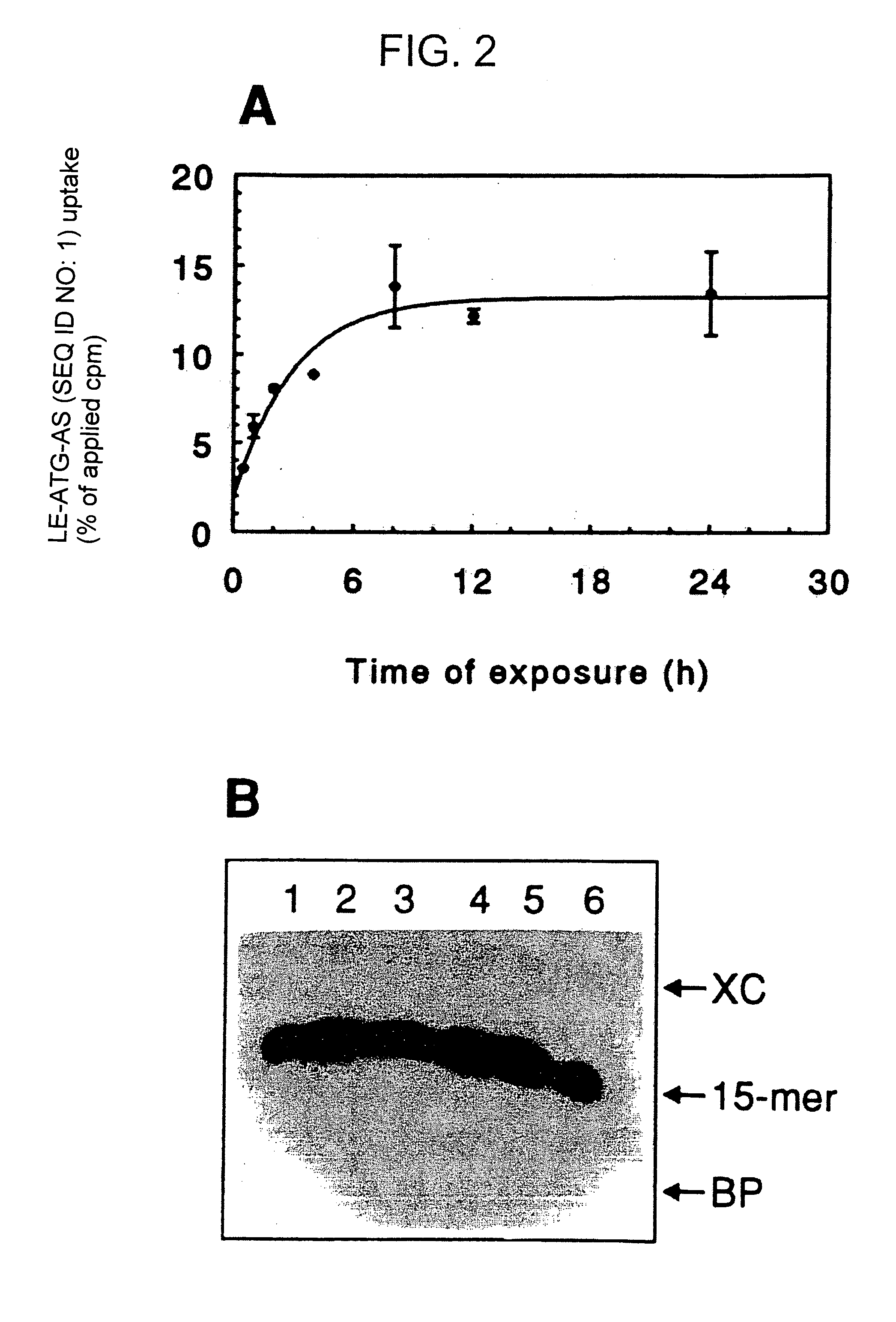Chemosensitizing with liposomes containing oligonucleotides
a technology of oligonucleotide and liposome, which is applied in the direction of biocide, drug composition, peptide/protein ingredients, etc., can solve the problems of tumor tissues becoming resistant to a particular chemotherapeutic, chemotherapeutic toxicity to non-targeted tissue, and fraught with problems, so as to improve serum stability and target capability
- Summary
- Abstract
- Description
- Claims
- Application Information
AI Technical Summary
Benefits of technology
Problems solved by technology
Method used
Image
Examples
example 1
Materials and Methods
[0078]Oligodeoxyribonucleotides
[0079]Oligodeoxyribonucleotide sequences directed toward the translation initiation site of human c-raf-1 cDNA were synthesized at Lofstrand Labs Limited (Gaithersburg, Md., USA) using beta-cyanoethyl phosphoramidite chemistry on a Biosearch 8750 DNA synthesizer. The sense (ATG-S (SEQ ID NO:3)) and antisense (ATG-AS (SEQ ID NO:1)) raf ODN sequences were 5′-GCAT-CAATGGAGCAC-3′ (SEQ ID NO:3) and 5′-GTG-CTCCATTGATGC-3′ (SEQ ID NO:1), respectively. One terminal base linkage at each end was modified to a phosphorothioate group using 3H-1,2-benzo-dithiole-3-1,1,1-dioxide as the sulfurizing agent. Oligos were synthesized at the 15 μm scale and purified on reverse phase chromatography columns. For quality control, a small aliquot of each oligo preparation was 32P-end-labeled and visualized by polyacrylamide gel electrophoresis (20% acrylamide and 5% bis) followed by densitometric scanning of the labeled products.
[0080]For synthesis of the ...
example 2
Materials and Methods
[0123]Cell Culture
[0124]SQ-20B tumor cells were grown as a monolayer in Dulbecco's modified Eagle's medium (DMEM) (GIBCO BRL, Grand Island, N.Y.) supplemented with 20% heat-inactivated fetal bovine serum (FBS), 2 mM glutamine, 0.1 mM nonessential amino acids, 0.4 μg / ml hydrocortisone, 100 μg / ml streptomycin, and 100 U / ml penicillin.
[0125]Oligodeoxyribonucleotides
[0126]A 20-mer phosphorothioate antisense ODN (ISIS 5132 / 5132: 5′-TCC-CGC-CTG-TGA-CAT-GCA-TT-3′) (SEQ ID NO:4) corresponding to the 3′-untranslated region (3′-UTR) of human c-raf-1 mRNA and a seven-base mismatched phosphorothioate antisense ODN (ISIS 10353 / 10353; 5′-TCC-CGC-GCA-CTT-GAT-GCA-TT-3′ (SEQ ID NO:5)) were designed and synthesized as described previously (Monia et al., 1996a,b). A 20-mer phosphorothioate sense ODN (5′-ATT-GCA-TGT-CAC-AGG-CGG-GA-3′ (SEQ ID NO:6)) was synthesized at Lofstrand Labs Limited (Gaithersburg, Md.) as described previously (Soldatenkov et al., 1997).
[0127]Preparation of C...
example 3
Materials and Methods
[0164]Preparation of DMTAP:PC:CHOL Liposomes
[0165]Liposomes having a molar ratio of 1,2-dimyristoyl-3-trimethyl ammonium propane (DMTAP): phosphatidylcholine (PC): and cholesterol (CHOL), of 1:3.2:1.6, and having encapsulated therein an antitumor raf oligonucleotide (ATG-AS (SEQ ID NO:1)) were prepared using substantially the same methods described previously.
In Vitro Results
[0166]A Enhanced Cellular Uptake of Antisense raf Oligodeoxyribonucleotides Encapsulated in Liposomes Comprised of DMTAP:PC:CHOL.
[0167]Dose-response uptake experiments: SQ-20B tumor cells were incubated with a mixture of radiolabeled (32P-γATP) and an indicated dose of unlabeled antisense raf oligonucleotide (ATG-AS (SEQ ID NO:1)) either in the liposome encapsulated form (LE-ATG-AS (SEQ ID NO:1)) or free form (ATG-AS (SEQ ID NO:1)) (FIG. 17). The treatment lasted for 4 hours at 37° C. in 1% serum containing medium. Following incubation, cells were washed with phosphate buffered saline (PBS),...
PUM
| Property | Measurement | Unit |
|---|---|---|
| molar ratios | aaaaa | aaaaa |
| concentration | aaaaa | aaaaa |
| concentration- | aaaaa | aaaaa |
Abstract
Description
Claims
Application Information
 Login to View More
Login to View More - R&D
- Intellectual Property
- Life Sciences
- Materials
- Tech Scout
- Unparalleled Data Quality
- Higher Quality Content
- 60% Fewer Hallucinations
Browse by: Latest US Patents, China's latest patents, Technical Efficacy Thesaurus, Application Domain, Technology Topic, Popular Technical Reports.
© 2025 PatSnap. All rights reserved.Legal|Privacy policy|Modern Slavery Act Transparency Statement|Sitemap|About US| Contact US: help@patsnap.com



